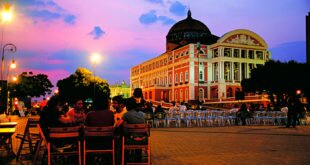From the forest's rubber plantations to the construction of cosmopolitan cities, latex is the flagship of the Brazilian economy between the late 19th and early 20th centuries.
Natural and produced from the sap of a tree called rubber tree (Hevea brasiliensis), rubber was responsible for writing part of Brazil's history, leaving important marks such as the annexation of the Acre territory and the construction of cities like Belém and Manaus.
Brazilian rubber was already being exported since the beginning of the 19th century. In the 1840s an average of 460 tons per year were exported at 45 pounds per ton. O boom of rubber sales occurred between 1879 and 1912 when rubber became the most sought-after product on the world market, according to Brazilian economist Celso Furtado (1920-2004). The end of the 19th century and the beginning of the 20th coincided with the birth and growth of the automobile industry, which needed rubber mainly for making tires. From this demand, in a short time, the entire Brazilian economy came to depend on latex, extracted from the rubber tree, a tree that existed in abundance and, until then, exclusively in the Amazon River basin.
From 1850 the amount of rubber exported rose to 1.9 thousand tons and, in the 1870s, 3.7 thousand tons of the product. The increase in demand caused prices to rise: from 118 pounds in the 1850s, to 125 pounds in the following decade, and to 182 pounds in the 1870s. Between 1909 and 1911, the figure reached 512 pounds per ton, as Celso Furtado states in his book Formação Econômica do Brasil.[1]
Engine of change
The sale of rubber transformed Belém and Manaus into models of wealth and refinement. In the passage from the 19th to the 20th century, the two cities underwent great urban remodeling, with the construction of great avenues, sewage and piped water networks, installation of electric light and tramways, which were still a luxury for São Paulo and Rio de Janeiro, for example. Bank houses and sumptuous public buildings were built. The Teatro Amazonas became a symbol of the economic and cultural prosperity provided by rubber.
Internal view of the Teatro Amazonas. Photo: Carla Lima/ Secretary of Culture of the State of Amazonas.
It was at this time that the territory of Acre, which belonged to Bolivia, was annexed to Brazil. The disagreements between the two countries began when Brazilian rubber tappers started invading the region to extract latex from the trees. Instead of an armed conflict, Brazil and Bolivia decided to negotiate. In 1903 the Treaty of Petrópolis was signed, by which Brazil bought Acre and committed itself to building the Madeira-Mamoré Railroad.
Work in the rubber plantations
The extraction of latex was one of the first experiences of work without the use of slave labor in Brazil. This is not to say that the conditions faced by the seringueiros were easy. As the retired professor from the Faculty of Social Studies, Federal University of Amazonas (UFAM), José Seráfico, writes, "while, in the forest wilderness, rubber tappers from dawn onward traveled their "roads", wounding the hevea brasiliensis and extracting the valuable sap from it, other agents played an indispensable role in shaping this new mode of production. The aviators intermediated the business, so that they were responsible for supplying the men of the forest with basic necessities, in exchange for a certain amount of rubber. In return, they received the result of the daily and exhausting labor of the rubber tappers, which they passed on to the export houses. In his opinion, the rubber tappers were left with growing debts with each new harvest. For this reason, there were few who escaped the condition of lifelong debtors of the rubber companies and aviators.
"The image of the rubber tapper as a "debt slave" is an exaggeration for most of the Amazon. They had significant autonomy and mobility," says Barbara Weinstein of New York University's Department of History. The rubber tappers usually owed money to an aviator, a boss who bought the rubber from the rubber tappers and provided the workers with food, tools, etc. However, as exploitation grew in a dispersed manner, the rubber tappers worked without much supervision. "Most were not 'enslaved' or 'coerced' in the way we understand those terms," he says. "But their lives were full of hardships and dangers, especially because of tropical diseases, the risk of snake bites, Indian attacks, and the loneliness and monotony of routine rubber work," Weinstein says. According to Weinstein, judging from the censuses of those years, the rubber tappers moved west whenever the amount of latex declined.
Despite this "freedom," there were some areas, especially far away and upriver, more remote parts of the Amazon, where the indigenous people were practically enslaved, Weinstein points out. In these areas - especially on the Putumayo River, which originates in Colombia - the rubber tree type was Castilla elastica (or Panama rubber tree) which, unlike the Hevea brasiliensis (the rubber tree), could not be used several times and was therefore destroyed in the production process. This would have contributed to brutal exploitative relationships in these regions. "In most of the Brazilian Amazon, the Hevea was the main source of latex and could be profitably exploited for many years, which was an incentive for long-term patronage and client relationships between the rubber tappers and the aviators. But where the trees would be destroyed by the harvesting process, the rubber traders were only interested in extracting as much labor as possible from people outside the local population, and to do so they resorted to extremely brutal methods to do so," he explains.
Decline
The beginning of rubber production in Asia was determinant for the decline of the Rubber Cycle in the Amazon. At the end of the 20th century, in what may be one of the first cases of massive biopiracy in Brazil, the English adventurer Henry Wickham (1846 - 1928) smuggled rubber seeds to England. While in the Amazon almost all rubber exported was wild, with trees scattered throughout the forest, which limited the amount of latex collected per worker, in the Asian colonies of the English (and later the Dutch and French), the trees were grown together on a "plantation" scheme. Moreover, in Asia, the trees were free of the fungus Microcyclus ulei that was beginning to afflict rubber trees in Brazil. "The Asian plantations greatly increased the supply of rubber and reduced production and transportation costs," says Weinstein.
According to the New York University researcher, the rubber cycle had some "dramatic" effects on the Northern region. "First, rubber was responsible for greatly increasing the population of the Amazon as a result of the influx of migrants from the Northeast," says the historian. "O boom also consolidated a commercial sector in many cities, giving them a more cosmopolitan appearance. This allowed certain institutions to survive after the cycle's decline," points out the Brazilianist. "At the same time, the impact on the indigenous population was not necessarily positive, as indigenous communities found themselves competing with rubber tappers and settlers for territory in the forest," she says.
For Pedro Paulo Funari, from the History Department of the State University of Campinas (Unicamp), the Rubber Cycle was a time of great economic investment, with opportunities for social growth of the lower classes and that brought unprecedented colonization of the region. "However, in a short time, it all ended in decline, due to international circumstances, with competitors in rubber production leading to the collapse," he says. "The lesson, or what remains from this period, is that economic surges by external demand (as happened in the last 12 years in Brazil because of the growth in Chinese demand for raw materials) do not guarantee long-term benefit. On the contrary, they induce the illusion that opportunities do not depend on long term commitment", believes the historian.
 Manaus Agile Amazonas tourism and culture
Manaus Agile Amazonas tourism and culture



